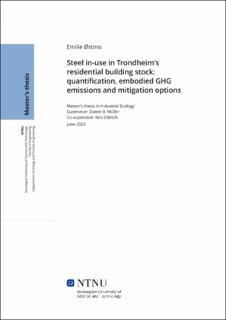| dc.contributor.advisor | Müller, Daniel B. | |
| dc.contributor.advisor | Dittrich, Nils | |
| dc.contributor.author | Østmo, Emilie | |
| dc.date.accessioned | 2023-09-09T17:20:30Z | |
| dc.date.available | 2023-09-09T17:20:30Z | |
| dc.date.issued | 2023 | |
| dc.identifier | no.ntnu:inspera:142433913:98292966 | |
| dc.identifier.uri | https://hdl.handle.net/11250/3088481 | |
| dc.description.abstract | Utviklingen av det bygde miljø bidrar betydelig til globale utslipp, og den forventede veksten i den globale bygningsmassen utfordrer arbeid mot utslippsreduksjon. For å takle disse utfordringene vil den sirkulære økonomien være viktig. Imidlertid er implementeringen i byggesektoren begrenset, og det er behov for innovative tilnærminger, som for eksempel urban gruvedrift, for å utnytte materialer i bygningsmassen. Å bedre forstå bygningsmassen, inkludert materialekvantiteter og avfallstrømmer, gjør det mulig for beslutningstakere å legge til rette for mer gjenbruk og redusere etterspørsel better jomfruelige ressurser. Stål er en av de primære materialene i bygningsmassen og representerer en av de største bidragsyterne til globale klimagassutslipp. Denne masteroppgaven basert på en bottom-up materialstrømanalyse-modell som kvantifiserer og analyserer stålet i bygningsmassen i Trondheim. Ved å bruke maskinlæring for å estimere strukturtyper, kombinert med spesifikke materialintensitet-faktorer, karakteriseres stålmengden fra kohortene 1990-2022 etter strukturtype, brukstype og bygningskomponenter. Det ble funnet at mesteparten av stålet finnes i fundamentet for alle type bygninger og i de strukturelle elementene til stålkonstruksjoner. Totalt sett ble det funnet at det er rundt 178 kilotonn stål i bygningsmassen, som har ledet til 173 kilotonn indirekte CO_2-utslipp. Noen tilnærminger for å redusere etterspørsel og øke gjenbruk og gjenvinning blir også diskutert. | |
| dc.description.abstract | The development of the built environment contributes significantly to global emissions, and the projected growth of the global building stock poses challenges to climate change mitigation. To address these issues, the circular economy will be fundamental. However, its implementation in the building sector remains limited, and there is a need for innovative approaches, such as urban mining, to exploit the material stock. Understanding the spatial and temporal aspects of building stocks, including material quantities and waste flows, enables stakeholders and policymakers to facilitate more reuse and reduce demand for virgin materials. Steel is one of the primary materials in the building stock and represents one of the biggest contributors to global GHG emissions. As such, this thesis is based on a bottom-up Material Flow Analysis model which quantifies and analyses the steel in the residential building stock in Trondheim. Using machine learning to estimate structural types, combined with specific MI coefficients, the steel stock of the cohorts 1990-2022 is characterised by structural type, use type and components. It was found that most of the steel exists in the foundations of all buildings and in the structural elements of steel buildings. In total, it was found that there are around 178 kilotons of steel in the stock, which has led to 173 kilotons of embodied CO2-emissions. Some approaches for reducing final demand and increasing reuse and recycling are also discussed. | |
| dc.language | eng | |
| dc.publisher | NTNU | |
| dc.title | Steel in-use in Trondheim's residential building stock: quantification, embodied GHG emissions and mitigation options | |
| dc.type | Master thesis | |
